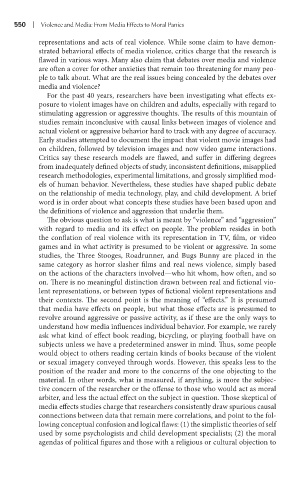Page 571 - Battleground The Media Volume 1 and 2
P. 571
0 | V olence and Med a: From Med a Effects to Moral Pan cs
representations and acts of real violence. While some claim to have demon-
strated behavioral effects of media violence, critics charge that the research is
flawed in various ways. Many also claim that debates over media and violence
are often a cover for other anxieties that remain too threatening for many peo-
ple to talk about. What are the real issues being concealed by the debates over
media and violence?
For the past 40 years, researchers have been investigating what effects ex-
posure to violent images have on children and adults, especially with regard to
stimulating aggression or aggressive thoughts. The results of this mountain of
studies remain inconclusive with causal links between images of violence and
actual violent or aggressive behavior hard to track with any degree of accuracy.
Early studies attempted to document the impact that violent movie images had
on children, followed by television images and now video game interactions.
Critics say these research models are flawed, and suffer in differing degrees
from inadequately defined objects of study, inconsistent definitions, misapplied
research methodologies, experimental limitations, and grossly simplified mod-
els of human behavior. Nevertheless, these studies have shaped public debate
on the relationship of media technology, play, and child development. A brief
word is in order about what concepts these studies have been based upon and
the definitions of violence and aggression that underlie them.
The obvious question to ask is what is meant by “violence” and “aggression”
with regard to media and its effect on people. The problem resides in both
the conflation of real violence with its representation in TV, film, or video
games and in what activity is presumed to be violent or aggressive. In some
studies, the Three Stooges, Roadrunner, and Bugs Bunny are placed in the
same category as horror slasher films and real news violence, simply based
on the actions of the characters involved—who hit whom, how often, and so
on. There is no meaningful distinction drawn between real and fictional vio-
lent representations, or between types of fictional violent representations and
their contexts. The second point is the meaning of “effects.” It is presumed
that media have effects on people, but what those effects are is presumed to
revolve around aggressive or passive activity, as if these are the only ways to
understand how media influences individual behavior. For example, we rarely
ask what kind of effect book reading, bicycling, or playing football have on
subjects unless we have a predetermined answer in mind. Thus, some people
would object to others reading certain kinds of books because of the violent
or sexual imagery conveyed through words. However, this speaks less to the
position of the reader and more to the concerns of the one objecting to the
material. In other words, what is measured, if anything, is more the subjec-
tive concern of the researcher or the offense to those who would act as moral
arbiter, and less the actual effect on the subject in question. Those skeptical of
media effects studies charge that researchers consistently draw spurious causal
connections between data that remain mere correlations, and point to the fol-
lowing conceptual confusion and logical flaws: (1) the simplistic theories of self
used by some psychologists and child development specialists; (2) the moral
agendas of political figures and those with a religious or cultural objection to

